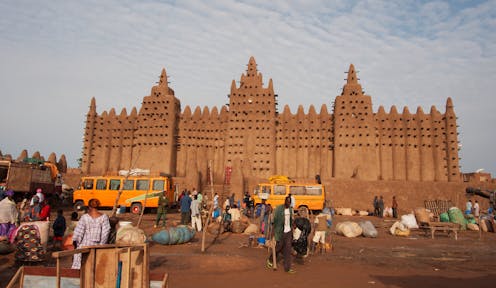
The Covid-19 pandemic will long be remembered for the lockdowns it imposed and the millions of lives it stole, particularly among the elderly. A recent Unesco report shows that it has also took a subtle yet large toll on our world heritage properties.
According to new research, world heritage sites in certain regions have suffered significant economic impacts of the pandemic, with those in Africa bearing the biggest brunt. In 2021, 52% of African world heritage properties reported Covid-related threats, including looting and insufficient materials to conserve sites. In comparison, 34% of properties in Asia and the Pacific reported similar issues, and only 15% of European and North American sites.
Choked off conservation revenues
The abrupt cut-off of tourism revenue is first to blame for these impacts. Several African countries are highly dependent on the sector, with tourism accounting for 10 to 20% of GDP in Botswana, Gambia and Namibia and over 20% in Cabo Verde and the Seychelles.
In 2020, international tourist arrivals dropped by 97% compared to 2019, and by 2021 were still 73% less than pre-pandemic levels. At its worst point in the pandemic, Africa’s travel and tourism sector lost $85.9 billion and 5.8 million jobs.
After global travel came to a halt, sites had to grapple with a sudden decrease in cash and an many temporary staff they could no longer keep on. Public subsidies, which cover the bulk of expenditures incurred by the management, staffing, conservation and maintenance of the sites, took a plunge in 44% of subsidized African world heritage sites. Only 8% saw their subsidies increase.
Looted treasures
Adding to the pain was the increased looting of world heritage sites during lockdowns. In Africa, one of the oldest cities of the continent, Djenné-Djenno, Mali, which is known to have been inhabited from 250 BC, has been heavily affected by illegal excavations and the looting of statues and other artifacts.
The logic is simple: the loss of income during the pandemic exacerbated the situation of those already living in poverty. Although this did not directly affect cultural property, many lost their incomes and some resorted to subsistence looting to survive. In such instances, the pandemic was the epicentre of a compounding impact on cultural heritage.
The risk of looting and illegal trade of cultural objects was found to have increased significantly during the pandemic. In March and April 2020, “online illicit trade in looted objects spiked”, according to the Antiquities Trafficking and Heritage Anthropology Research Project. Insufficiently protected archaeological sites became an easy target for looting or other forms of illegal access. The Antiquities Trafficking and Heritage Anthropology Research Project (ALTHAR), which monitors Facebook groups that serve as marketplaces for cultural antiquities – many often looted – found that many gained hundreds of thousands of new members during the pandemic, raising concerns.

Beyond objects that could be looted, the Covid-19 pandemic also posed a threat to the world heritage sites themselves. For example, lockdowns brought a halt to 400-year-old social and cultural rituals for the maintenance of the Konso Cultural Landscape, which is made up of stone-walled terraces and fortified settlements in South Ethiopia’s Konso Highlands. Retaining the soil from erosion and collecting water that is vital for agriculture, the terraced fields represents not only a central cultural tradition, but also an infrastructural necessity. Prior to the pandemic, tourism as the largest income stream and even then, provided only the bare necessity of support.
The precipitous drop in tourism thus worsened the population’s already precarious financial situation. Because the price of building materials also climbed during the pandemic, locals began to use stones from the terraces for constructions. The dire situation was aggravated by absence of on-site site security, allowing some looting to occur.
The (mis)use of terrace stones for house construction in the Konso Highlands demonstrates the real threat to the preservation of cultural heritage sites posed by crises such as the Covid-19 pandemic. It is worth recalling the 1972 Convention Concerning the Protection of the World Cultural and Natural Heritage, in which all signatories recognised “that the task of ensuring the identification, protection and conservation of the cultural and natural heritage rests primarily with the state” (Art. 4).
How to stop this from happening in future
The severe impacts of the pandemic on tangible and intangible cultural heritage have highlighted the fragility of world heritage, especially in the Global South. To build the resilience required to manage future health crises, conflicts, and natural disasters brought on by climate change, a more sustainable approach is needed.
First, existing political and international legal instruments must be strengthened. At present, governments rely on a range of legislative measures to protect their World Heritage Sites. In 2017, the UN Security Council unequivocally condemned the looting and smuggling of cultural good during armed conflict from Iraq and Syria. Nearly a half century earlier, Unesco’s 1970 convention on the Means of Prohibiting and Preventing the Illicit Import, Export and Transfer of Ownership of Cultural Property prohibits the “illicit import, export and transfer of ownership of cultural property”.
Currently, 32 countries in the African region are parties to the 1970 convention, which is binding on all parties and requires that they abide by the legal standards set forth. However, its effectiveness depends heavily on local implementation and enforcement. Implementation through national laws and enforcement structures varies greatly from country to country. Nevertheless, there have been efforts in the African region to strengthen and harmonize cultural policies, and thus also to better protect African cultural properties.
Despite being under a legal obligation to ensure the protection and preservation of their nation’s cultural heritage, in times of crises, states didn’t seem to be fully able to fulfil their duties. To fill the gap, international support programs and private initiatives have stepped in to support world heritage sites. The initiative #SOSAfricanHeritage by the German Commission to Unesco (DUK) has supported 34 projects in 22 African countries in 2020/2021 with up to 25,000 euros with the specific goal. Still, we must guarantee steadier public funding for sites, rather than relying on emergency responses.
As detailed, the Covid-19 pandemic had numerous negative impacts on cultural heritage. While primarily a health crisis, the pandemic hit cultural heritage hard, inflicting significant damage. during the pandemic period can be traced to the pandemic at its core and its social and economic consequences. Be it the neglect of world heritage sites, the decline and absence of tourism, or looting in its various forms.

50th anniversary of the World Heritage Convention (16 November 2022): World Heritage as a source of resilience, humanity and innovation.
The authors do not work for, consult, own shares in or receive funding from any company or organisation that would benefit from this article, and have disclosed no relevant affiliations beyond their academic appointment.
This article was originally published on The Conversation. Read the original article.







